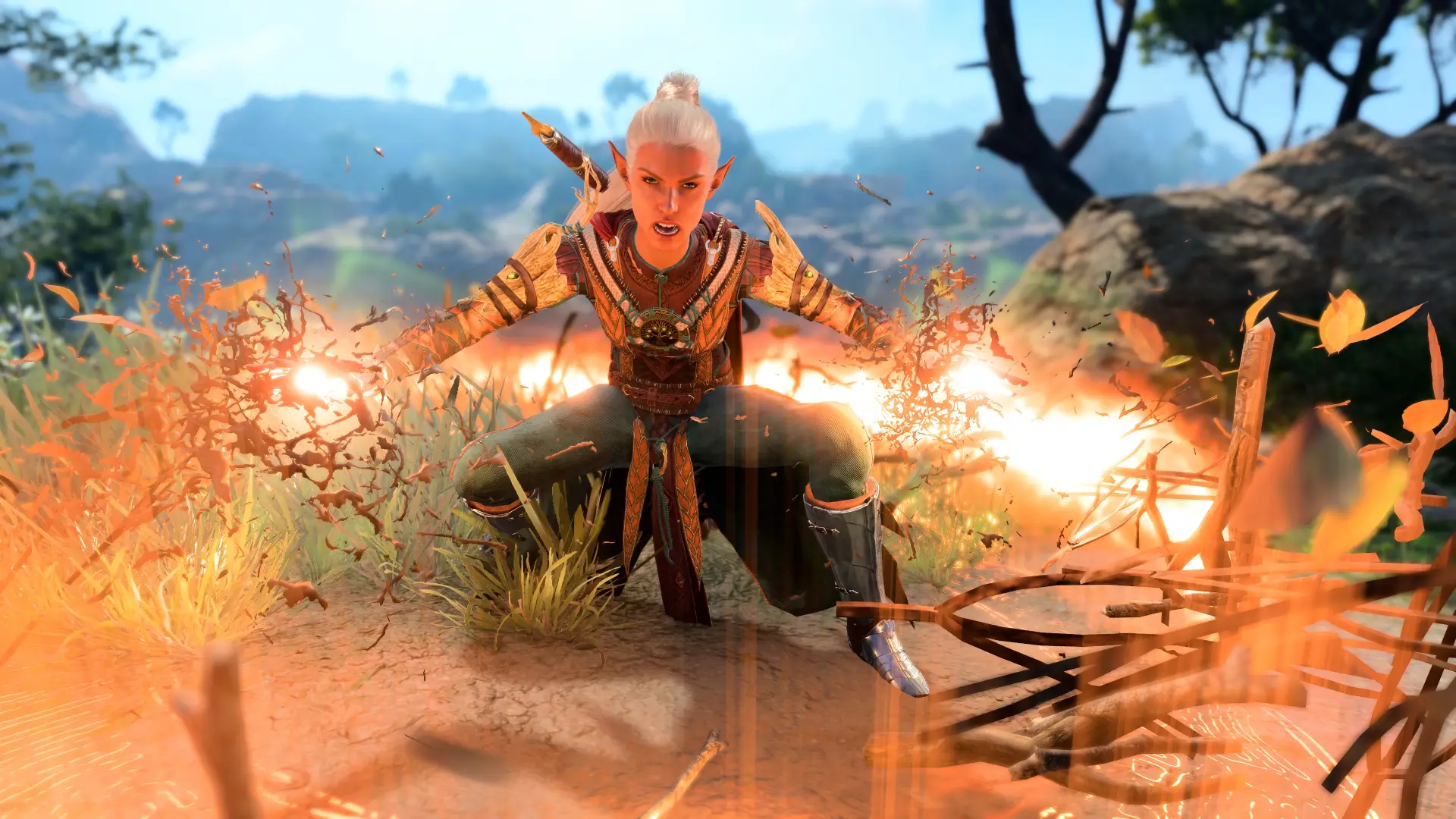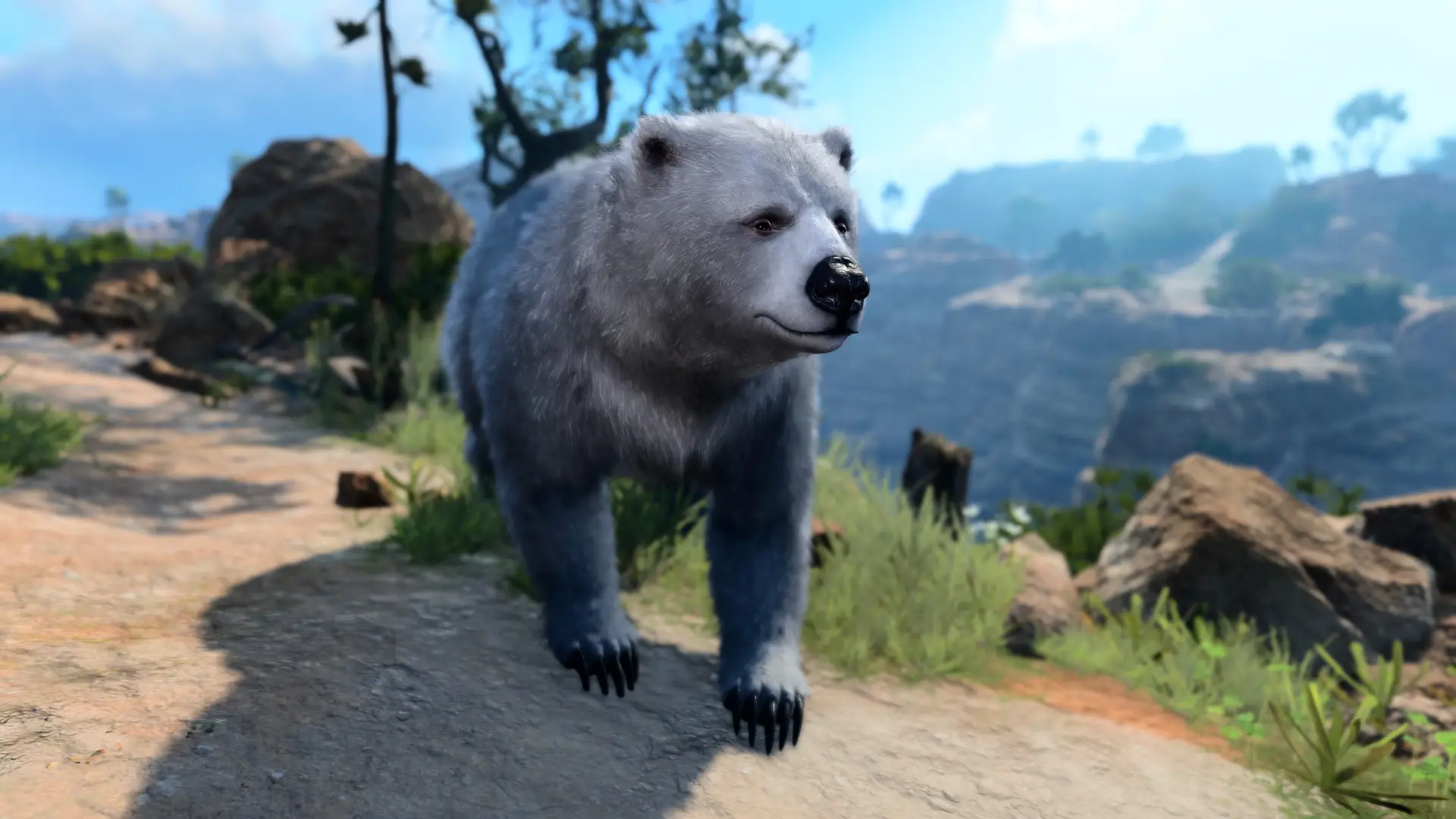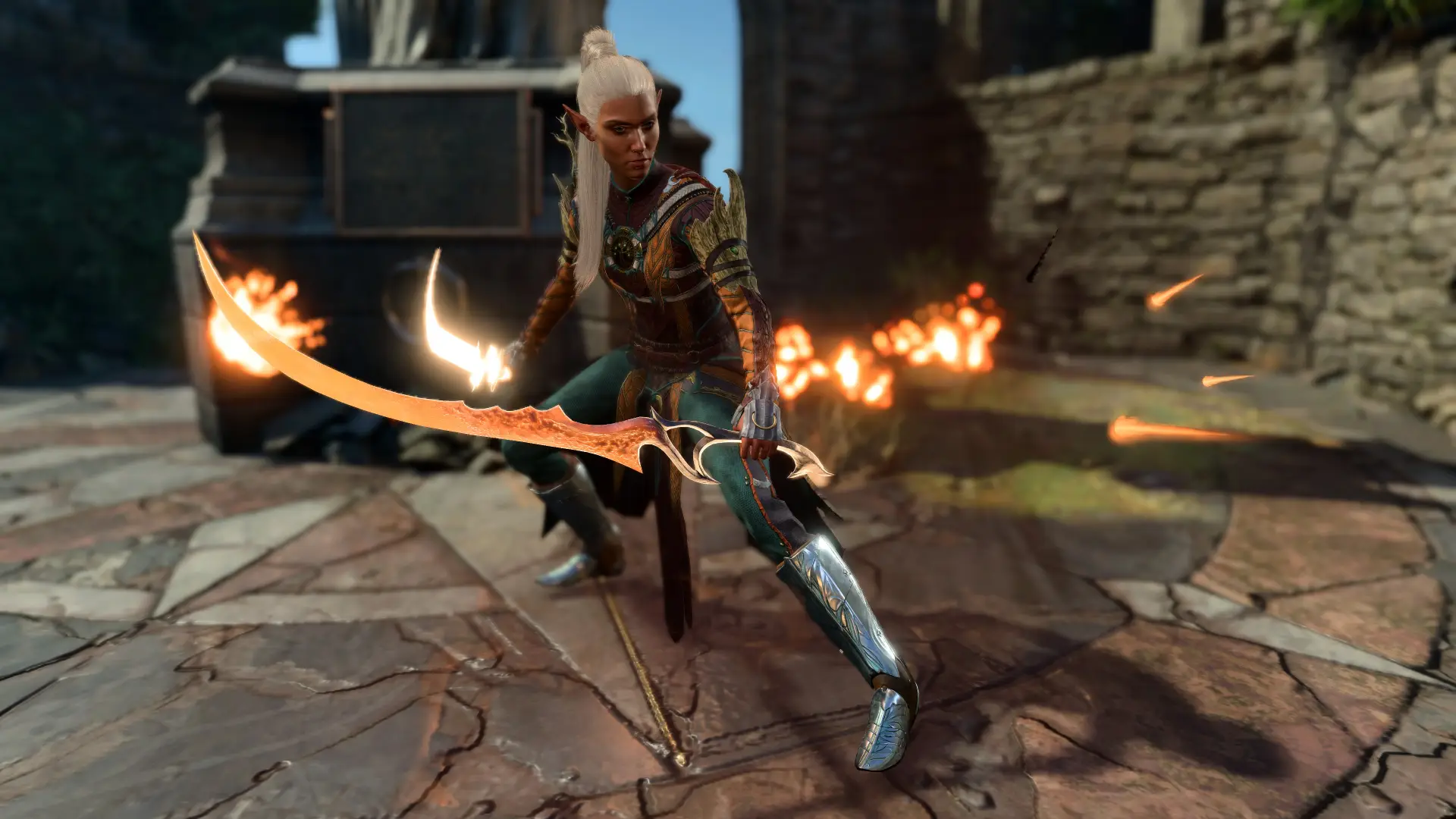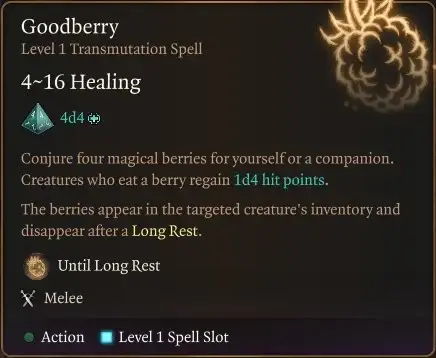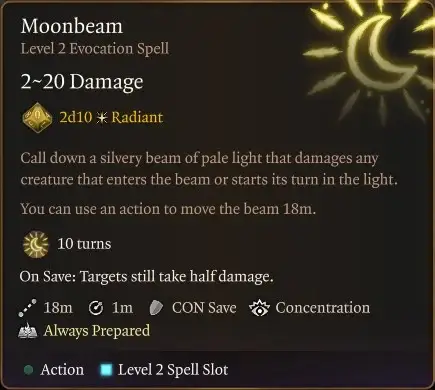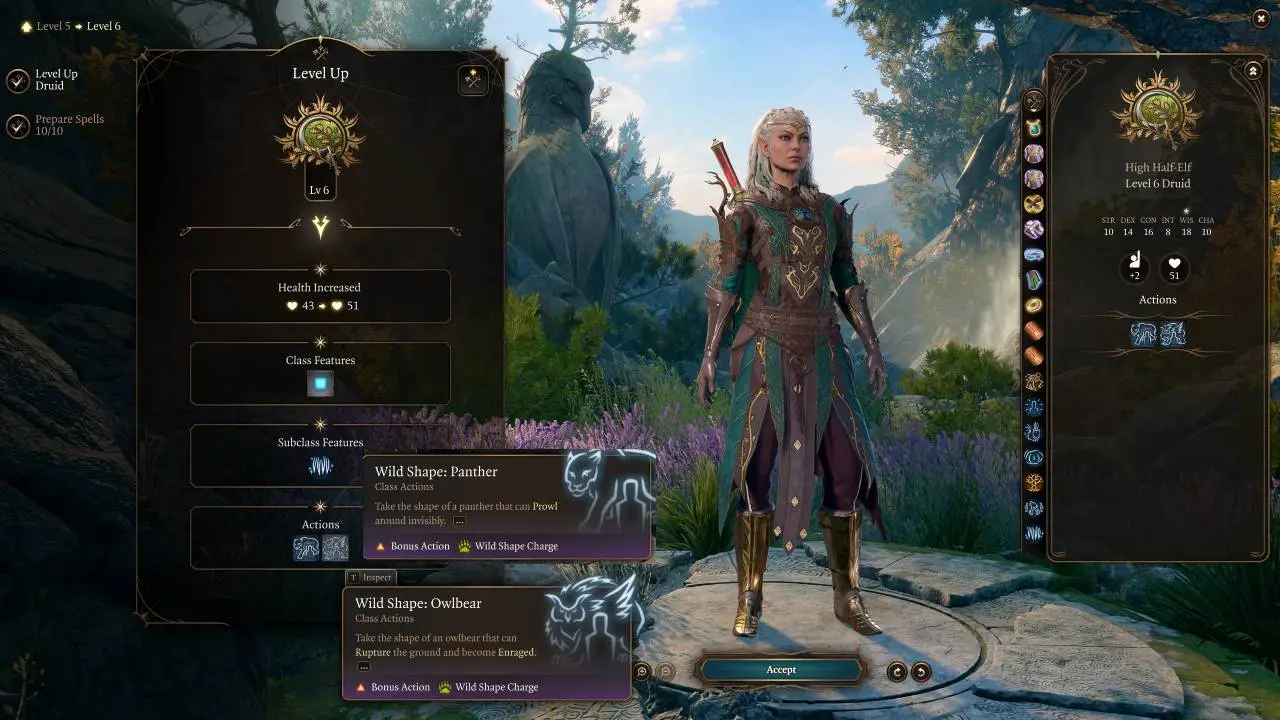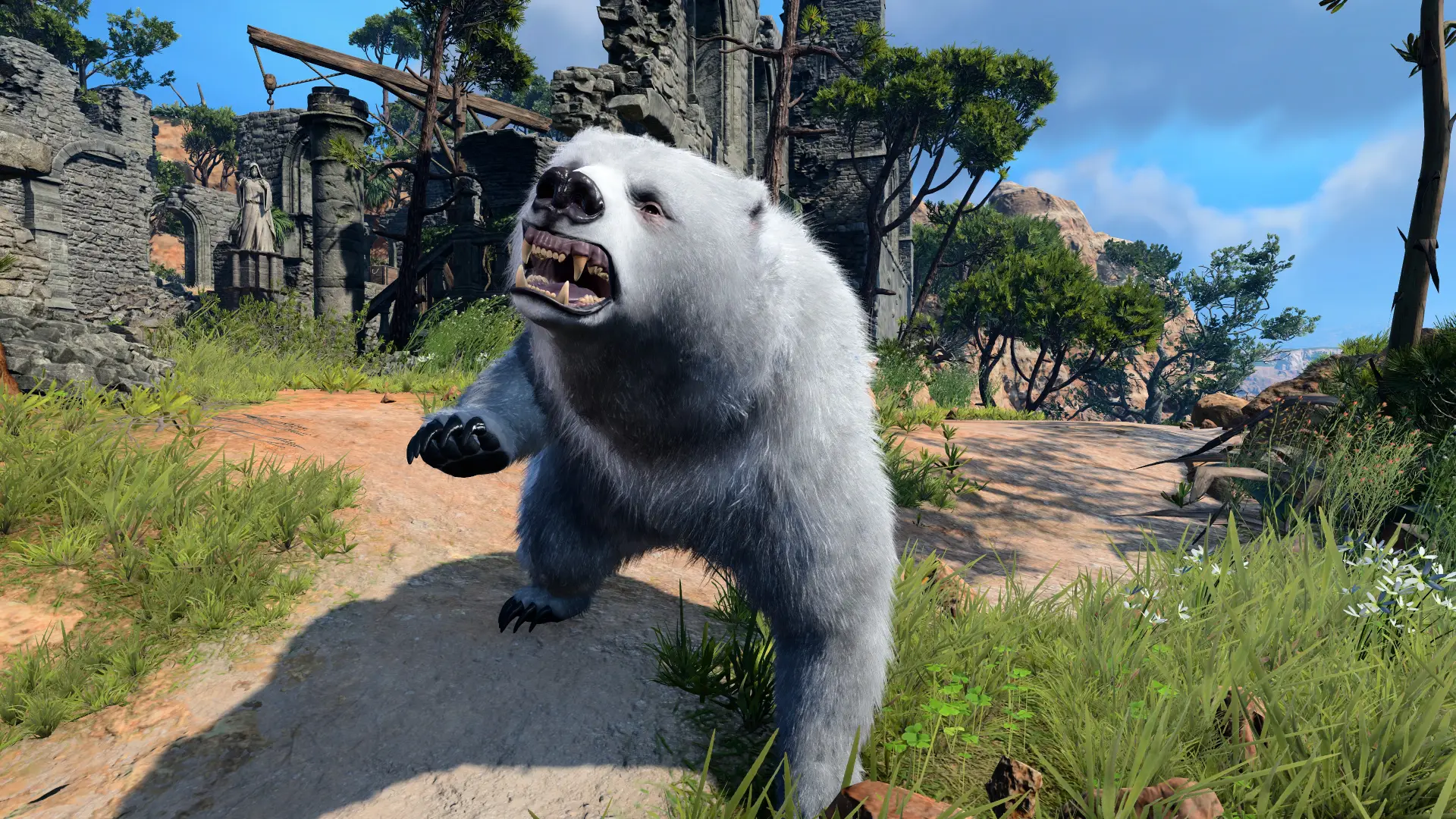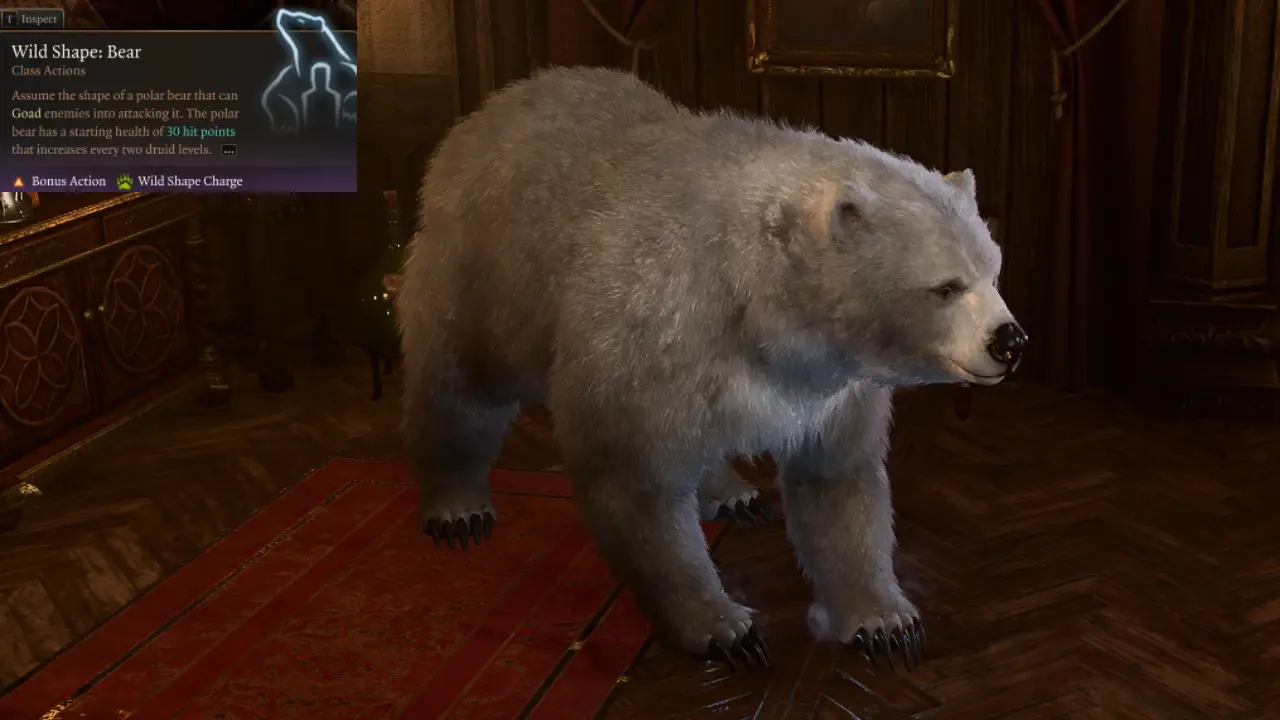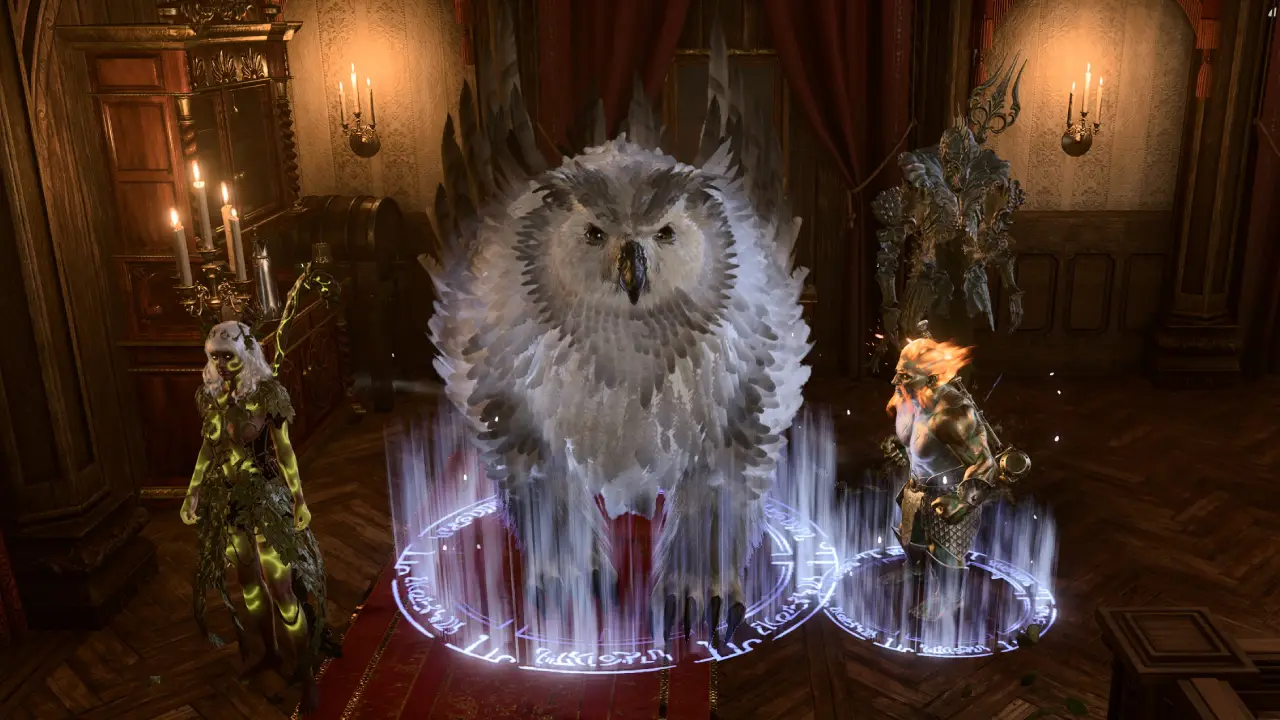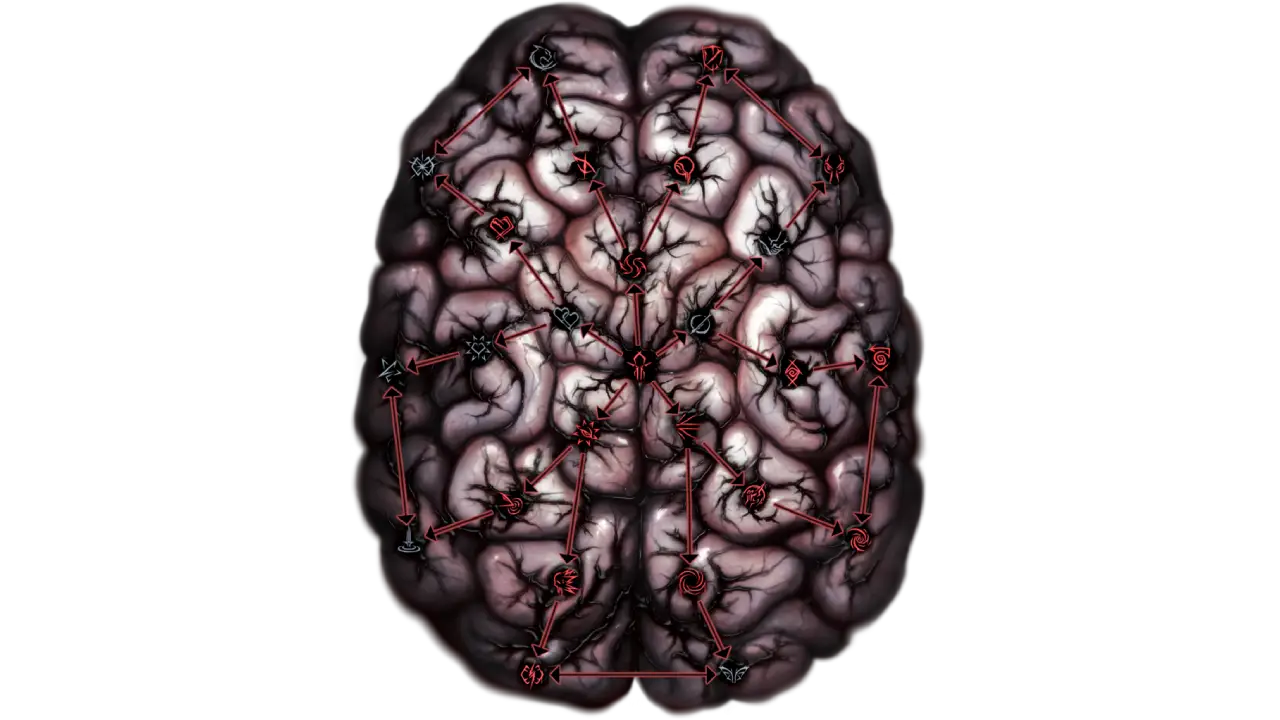Welcome to the Best BG3 Druid Build Guide. The Druid class in BG3 excels as a versatile and powerful choice, offering healing, support, damage, and tanking capabilities. We use the Circle of the Moon subclass because it is the strongest for the BG3 Druid.
Table of Contents for the BG3 Druild Build:
- Introduction to the Druid Class
- Druid Leveling Progression
- Druid Wild Shape Forms & Summons
- Druid Equipment
- Druid Tips & Tricks
To get an overview of all classes please visit the BG3 Classes overview page. For more Druid subclass builds, visit:
- BG3 Circle of the Land Druid Build
- BG3 Circle of the Spores Druid Build
- BG3 Halsin Build – Companion Setup
- BG3 Jaheira Build – Companion Setup
Druids are versatile avatars of nature and pure extensions of their power. Druids focus on supporting the party, ensnaring and destroying foes in Baldur’s Gate 3. The Circle of the Moon Druid Build is great at tanking enemies because of its strong Wild Shape transformations! All animal transformations have their own Hit Points, abilities and attacks. More info is available in the BG3 Druid Wild Shape section of the BG3 Druid Build. The BG3 Circle of the Moon Druid Build works on both PC and Console (PS5 and Xbox Series X/S).
Here is a quick pros and cons list for the BG3 Druid Build:
Druid Build Strengths
Druid Build Weaknesses
BG3 Druid Class Guide
Before we start with the build let’s explain how the Druid class works, to get a good sense of how you will play this class in Baldur’s Gate 3. First and foremost the BG3 Druid Build’s main class feature is the different Wild Shape forms you can transform into. You will get access to more Wild Shape forms with higher levels. You can also read our BG3 Druid Wild Shape Forms Guide to see all the different transformations and what they do. You will get new forms at level two, four, six, eight and ten. Of course, the higher-level transformations are more powerful. However, even the early game transformations are still widely used because of their mechanics outside of combat.
The neat thing about the Wild Shape is that you get a free second life. You can start combat as a bear (high Hit Points) and when his hit points are reduced to 0 your Druid will transform back into normal form and still has full hit points. This alone makes Druid super tanky and a good frontline combatant.
One of the early transformations you get is the Cat Wild Shape. The Cat isn’t used in combat, but it is extremely useful to get past NPCs and steal stuff as they won’t pay attention to you. You can also lure enemies into a location with the Meow action. Another great Wild Shape form that is widely used is the Owlbear Wild Shape that you get at level 6. The Owlbear has high Hit Points and because it is so heavy it can knock prone enemies around it with Rupture, one of our favorite transformations for our build.
To transform you will need so-called Wild Shape Charges, these can be replenished during a Short Rest. At level 5 you will gain the passive Wild Strike that allows you to make additional attacks when transformed.
Not only can you transform into creatures, but you can also summon creatures as Druid! At level 7 you will be able to use Conjure Minor Elemental and Conjure Woodland Being. At level 9 you can use Conjure Elemental. This means that our build will be able to use three Summons and its Wild Shape at the same time, good luck fighting against this! In the image below, you can see the Azer Minor Elemental (39HP), the Woodland Being (22HP), the Fire Myrmidon (123HP), and the Owlbear transformation, which has 122 HP and 22 THP (Temporary Hit Points) with Armour of Moonbasking, more about this in the Druid Build Gear section.
BG3 Druid Subclass Comparison
The Druid Class has a total of four different subclasses available to them in BG3. The subclasses are called: Circle of the Moon, Circle of the Land, Circle of the Spores and Circle of the Stars. While many of the features are similar, there are clear differences between the subclasses in Baldur’s Gate 3:
| Aspect | Circle of the Moon | Circle of the Land | Circle of the Spores | Circle of the Stars |
|---|---|---|---|---|
| Focus | Wild Shape combat | Spellcasting and support | Necrotic damage and hybrid | Starry Forms |
| Strength | High survivability, strong melee damage | Huge variety of Spells | Necrotic damage, summoning | Enhance and heal |
| Weakness | Limited Spell use in Wild Shape form | Weak in melee | position-dependent abiltities | Weak in melee |
| Best For | Tanking and melee combat | Support and Control of combat | Hybrid melee and necrotic damage | Archer, Chalice and Dragon Forms |
Circle of the Moon
This subclass excels at the Druid’s ability to transform into powerful Wild Shape beast forms. They get access to more powerful Wild Shape beasts early in the game. Allowing them to play the role as Tank early on. Additionally, they also have higher hit points while in Wild Shape form. And if you drop to zero health in your Wild Shape, you will turn back to your normal state with full health! Early on we use the Bear, later we use the Owlbear because of their massive hit points and sheer force they can unleash. This is the subclass we use for the BG3 Druid Build on this page.
Circle of the Land
This subclass channels the natural arcana flowing through the earth to cast powerful druidic magic. This subclass gains additional spells based on the type of terrain they choose as their circle at level 3, such as Arctic, Coast, Desert, Forest, Grassland, Mountain, Swamp or Underdark. This is best played as a spellcaster and support character because of the amount of spells you can use. However, it is quite weak in melee combat.
Circle of the Spores
Viewing death, necrosis, fungal growth and sporulation as just another part of life, you can manipulate such spores to augment yourself and harm your foes. This subclass has access to some darker forms of magic such as necromancy, allowing you to summon poisonous clouds, diseases and even zombies. Think of this as sort of a spellcaster damage dealer with some hybrid mechanics.
Circle of the Stars
This subclass draws power from the stars, adopting one of three Starry Forms: Archer, Chalice, or Dragon. The Archer excels in radiant damage, the Chalice boosts healing, and the Dragon enhances damage. These celestial forms combine striking visuals with versatile tools for healing, combat, or strategy.
Why Choose the Circle of the Moon Subclass for our BG3 Druid Build
The Druid selects the subclass at level two, don’t miss it. We use the Circle of the Moon subclass with this BG3 Druid Build. Here is why the Circle of the Moon subclass is considered superior:
- Enhanced Wild Shape: Moon Druid exclusive Wild Shapes early game like the Bear and the Dire Raven. When you reach zero health with the bear you transform back to human form with full HP.
- Tankiness: The Bear grants high Hit Points and deals massive melee damage.
- Strong from the start: Because of the powerful Bear Wild Shape form unlock in level two you are basically steamrolling most early content without issues.
- Adaptability: There is pretty much a Wildshape for every combat situation (Offensive, Defensive, Exploration etc)
Additionally, later, we will use the Owlbear Wild Shape form, which is basically an upgraded Bear form that deals massive damage due to its sheer size and can tank amazingly, too.
Character Creation (Level 1) for BG3 Druid Build
In this section, we will guide you through the best options in Character Creation for the BG3 Druid Build. While you can deviate somewhat from this if you want, following these steps will result in the most powerful starting point for your Druid Build.
Race
The race you select has no bearing on your Ability scores, which are the most important factor at play. This gives players more freedom to choose any race and class combination that they wish, without having to worry about being pigeon-holed into a “meta” race for their class.
However, there are still some useful passive features sourced from your race and subrace, which may be of advantage when it comes to the Druid build. Some interesting options are:
- Wood Elf or Wood Half-Elf – Gains very high Movement Speed, great for quickly taking advantageous positions and outrunning enemies.
- Gold Dwarf – Gets +1 bonus HP per Level.
- Halfling, Any – Lets you reroll your die whenever you roll a 1. This makes a Critical Miss extremely unlikely.
- Forest Gnome – Gets Advantage on Intelligence, Wisdom and Charisma Saving Throws, and a cool thematic pick for the Druid.
Don’t worry if you don’t want to go with any of these races. As mentioned above, your chosen race is of fairly low importance in Baldur’s Gate 3 post release.
Class Selection
Here we want to select the Druid class for our BG3 Druid Build.
Cantrips
You can choose two Cantrips to start the game with. We recommend the following options:
- Thorn Whip, Transmutation Cantrip – Thorn whip does a modest amount of piercing damage, but its most useful application is its ability to control the position of enemies on the battlefield. If an enemy is entrenched in a strong position and giving you a hard time, you can use Thorn Whip to pull them towards you. This is especially useful on enemies who have an elevation advantage over you. Thorn Whip can pull them down to your level. Depending on how high they are, they may receive additional falling damage, possibly even killing them immediately.
- Shillelagh, Transmutation Cantrip – Shillelagh imbues your staff or club with magical energy for the next 10 turns, causing it to deal extra bludgeoning damage. This spell might seem fairly mediocre at first glance, but it’s actually a huge blessing for us in the early game, as it also causes our melee attacks to use our Wisdom instead of our Strength, massively improving your attack rolls if you built the Druid as recommended above. This is also a Bonus Action, meaning you can cast it and then perform an attack on the same turn.
Background
The following Backgrounds are the best choice for your Druid:
- Acolyte
- Folk Hero
- Outlander
These backgrounds give us the most proficiency with Wisdom-based skills. You will want to have high Wisdom on your Druid, since this is the ability needed for spellcasting on this class – these backgrounds fit nicely with that.
Abilities
For the Druid, Wisdom is the most important ability, followed by Constitution and Dexterity. We want 16 points in Wisdom to improve the efficacy of spellcasting, and 16 in Constitution will improve your HP and your ability to maintain Concentration on your spells. Dexterity helps to improve your Armour Class.
It usually makes sense to keep the ability scores on even numbers as much as possible, since your Ability Modifiers (i.e. Wisdom Modifier) only gets changed for every second point – for example 12 Wisdom = +1 Wisdom Modifier, 14 Wisdom = +2 Wisdom Modifier, etc.
- 10 Strength
- 14 Dexterity
- 16 Constitution
- 8 Intelligence
- 16 Wisdom
- 10 Charisma
Skill Proficiencies
It’s not hugely important which skills you choose, for the most part these are used in dialogue and other such actions. However, you’re likely going to have more success choosing skills that fall under Wisdom, as you’ll be building with a high Wisdom score anyway due to its benefit on combat.
Choosing Insight and Perception will work well for us, as these skills are already boosted by our Wisdom and will be boosted by 2 more points by choosing to have proficiency with them. These skills are also great for detecting secrets in dialogue and exploration, which can lead to a richer and more enjoyable playthrough.
Spells
You also need to select four Prepared Spells to begin the game with. On the Druid, your spells need to be Prepared in order to use them. We recommend choosing the following four spells:
- Entangle, Conjuration Spell – Entangle is a great spell for messing with groups of enemies and giving them a hard time. You’ll cast an AOE of vines, and enemies inside the AOE or moving through it will need to pass a Strength check. If they fail, they’ll become entangled which will hinder their movement. Maintaining the spell requires Concentration, explained below.
- Thunderwave, Evocation Spell – Thunderwave produces a large directional wave originating from your character, knocking back all characters and objects in its path. It also deals some Thunder damage. Not only is this a decent AOE damage spell, it’s also great for creating space, and you can knock enemies off ledges or cliffs, subjecting them to additional fall damage or even an immediate demise.
- Faerie Fire, Evocation Spell – Faerie Fire is an AOE debuff spell, placing an effect on characters in the area that improves Attack Rolls against them. It requires Concentration to maintain the spell, but you’re generally going to have considerably better results from attack rolls as long as you can maintain this on your targets. Just be careful not to place it on your allies by accident. This also pulls targets out of any effects that make them invisible.
- Healing Word, Evocation Spell – Healing Word is a nice healing spell that can be used at long range. At first glance, you might think that Cure Wounds is better, due to its higher potential healing roll. However this is a mistake Cure Wounds can only be cast at Melee Range which gives it a major disadvantage versus Healing Word, and Healing Word is also a Bonus Action, meaning you can still attack or cast another cantrip or spell on the same turn.
Note that the number of Prepared Spells we can have depends on our Character Level and our Wisdom. Each character Level will give another slot, and increasing our Wisdom skill further will also add to this.
Concentration Mechanic Explained
The Concentration mechanic is important to understand for any spellcaster including the BG3 Druid class. Many spells that leave a lingering effect on an enemy or an area require Concentration to maintain. You can see if a spell requires Concentration on its tooltip.
What this means is that whenever the caster takes damage, they must go through a Concentration Check. Failing the check will break Concentration and put an end to any ongoing Concentration spells that they were maintaining. Having a higher Constitution score improves your chances of passing Concentration Checks.
Druids can use the following weapons and armour at the beginning:
- Weapons: Clubs, Daggers, Javelins, Maces, Quarterstaffs, Scimitars, Sickles, Spears, Pikes, Halberds, Glaives
- Armours: Light Armour, Medium Armour, Shields
BG3 Druid Build Leveling Roadmap
The table below will give you a quick overview of what features you can expect from the BG3 Druid Build while leveling up, and you can think of it as a quick roadmap overview. It is important to note that you will also gain additional spell slots through leveling. That means the amount of spells you can actively use in combat will grow over time in your BG3 playthrough.
Click on the level in the table to get a more detailed breakdown of what to do; the table is only here to give you a quick overview.
| Level | Milestones |
|---|---|
| Level 1 | Character Creation: Race, Class, Cantrips, Background, Abilities, Spells |
| Level 2 | Subclass Selection, Tier 1 Spells, Wild Shape: Bear, Badger, Cat, Wolf, Spider |
| Level 3 | Tier 2 Spells |
| Level 4 | Feat, Spell, Cantrip, Wild Shape: Dire Raven, Deep Rothe |
| Level 5 | Tier 3 Spells, Wild Strike Passive (Stronger Wild Shapes) |
| Level 6 | Wild Shape: Owlbear |
| Level 7 | Tier 4 Spells |
| Level 8 | Feat, Wild Shape: Sabre Toothed Tiger |
| Level 9 | Tier 5 Spells |
| Level 10 | Cantrip, Wild Shape: Dilophosaurus, Myrmidon |
| Level 11 | Tier 6 Spells |
| Level 12 | Feat |
Early-Game Leveling 2-4 for your BG3 Druid Build
The BG3 Druid Build early-game leveling process consists of levels 2-4. At level two, you can select your Druid Subclass Circle of the Moon and you get new Tier 1 Spells and the Wild Shape forms Bear, Badger, Cat, Wolf, Spider. Level three unlocks Tier 2 Spells and level four allows you to select a Feat and unlock new Wild Shape forms Dire Raven and Deep Rothe.
- Level 2 – Subclasses Selection and Wild Shape forms
- Level 3 – Tier 2 Spells
- Level 4 – Feat + New Wild Shape forms
Level 2 – Subclass Selection and new Wild Shape Forms
When you reach Level 2, you will need to choose which Subclass you want to use for your BG3 Druid Build. You can view more information about the three subclasses here.
For this Druid build, we’ll be using the Circle of the Moon subclass, which gives us greater options with animal transformations, something that makes your character more versatile both inside and outside of combat.
With the Circle of the Moon subclass, you can transform into a Bear, a very tanky animal that also hits quite hard, and has the ability to Goad enemies, effectively turning your character into a tank. The great thing about transforming into an animal is that being “killed” in this form just puts an end to the transformation, turning you back into your normal form. Making good use of the Wild Shape mechanic therefore makes the Druid arguably the most enduring class in the game.
Besides choosing your subclass, you can also unlock a new spell. You may want to get the Goodberry Spell, which lets you conjure consumable berries that heal whoever eats them for up to 16 hitpoints. This is great for keeping your party healthy. Another option is Speak with Animals, which allows you to talk to animals as though they were humans, unlocking hidden interactions.
Level 3 – Tier 2 Spells
At Level 3 your Druild Build will gain access to second level spells for the first time (this can be a bit confusing at first, but just try to think of spell levels as a completely separate system from character levels).
You’ll also receive at least one more spot for a Prepared Spell. It’s a good idea to begin adding Level 2 Spells to your arsenal here. Make sure to have a good mix between Level 1 and Level 2 spells on your Prepared Spells. Some good Level 2 options are:
- Moonbeam, Evocation Spell – Moonbeam summons a beam of Radiant damage on a small area of the ground, dealing up to 20 damage per turn to all within while it is maintained. Maintaining the beam requires Concentration. A particularly useful thing about this spell is that you can use a Bonus Action each turn to relocate the beam, allowing you to keep moving it to the new location of enemies without needing to cast the spell again, provided you maintained your Concentration.
- Heat Metal, Transmutation Spell – Heat Metal is a damage and debuff spell that can be targeted on an enemy using any metal weapon or armour. The target takes some fire damage and must either drop the weapon or receive a Disadvantage on their Attack Rolls and Ability Checks. If you maintain Concentration, you can apply the effects again on subsequent turns by spending a Bonus Action.
- Spike Growth, Transmutation Spell – Spike Growth covers an AOE (6 metre radius) with spikes, dealing piercing damage to enemies who walk through it, every 1.5 metres they move. It also halves their movement speed in the area. Enemies cannot perform Saving Throws to resist this damage, making it particularly useful. You can also maintain the effect for multiple turns, as long as you can keep Concentration.
These spells all provide great options for controlling the battlefield and disrupting your enemies’ plans with troublesome AOEs and debuffs. You can add all three immediately, or just take 1-2 for now and wait until you have more Level 2 Spell Slots before getting the others.
Level 4 – Dire Raven and Deep Rothe Transformation Unlocks
When you reach Level 4 in Baldur’s Gate 3 with your Circle of the Moon Druid Build, you will need to choose a Feat.
For this build, we use the Ability Improvement Feat, which gives you an extra 2 points to allocate to abilities of your choice. Put the points in Wisdom, to further improve Spellcasting. This should give you 18 Wisdom in total.
You’ll also need to choose another Spell and another Cantrip.
For the Spell, the one you choose depends on how many of the second-level spells from the previous section you decided to use. If you didn’t get all of them, then it’s time to add one of the ones you missed. If you already slotted all of them, then get Flaming Sphere. This is a long-range AOE spell that deals fire damage to enemies within and acts as a light source. If you spot a group of tightly packed enemies who haven’t noticed you yet, then you can use this spell to initiate combat and get an immediate edge, as you’ll already have damaged them quite a bit.
For the Cantrip, it’s always a good idea to get the Guidance Cantrip sooner or later in your playthrough, as this gives a +4 bonus in Ability Checks that can apply to both you and your allies. You can choose to activate it in non-combat checks by simply choosing it in the dice roll screen.
Additionally, you also get access to two new Wild Shape forms for your Druid Build at level 4:
The Dire Raven Wild Shape form is great for scouting ahead and reaching far-away places that you can’t jump to normally.
Mid-Game Leveling 5-8 for your BG3 Druid Build
The BG3 Druid Build mid-game leveling process consists of levels 5-8. At level five you unlock Tier 3 Spells and gain the Wild Strike passive that makes your Wild Shapes more powerful. At level six, you gain the ultimate Wild Shape from Owlbear, which is our main form going forward! At level seven you unlock Tier 4 Spells. At level eight, you unlock a new Feat and the Wild Shape Sabre Toothed Tiger.
- Level 5 – Tier 3 Spells, Wild Strike Passive
- Level 6 – New Wild Shape Owlbear
- Level 7 – Tier 4 Spells
- Level 8 – Feat, New Wild Shape Sabre Toothed Tiger
Level 5 – Tier 3 Spells and Wild Strike Passive Unlocks
When you reach Level 5 as a Druid, you’ll gain access to third-level spells. The following two spells are great options to slot at this point:
- Call Lightning, Conjuration Spell – This is a lightning AOE spell. What’s great about the spell is that you can call lightning again for free on subsequent turns, as long as you keep concentration.
- Sleet Storm, Conjuration Spell – Sleet Storm has a large radius of 9 metres and creates an ice surface within that AOE, which can be really bothersome for enemies within, slowing down their movement and possibly making them slip over. It also breaks the concentration of spellcasters, so it’s a good counter for enemy mages. You can keep the Sleet Storm going for several turns, as long as you maintain your own Concentration.
Your Wild Shapes become more powerful as you unlock the Wild Strike passive. Whenever you make a successful unarmed attack in animal form, you get an extra attack on the same turn.
Level 6 – Owlbear Transformation finally unlocks
At Level 6, the BG3 Circle of the Moon Druid Build gains more buffs and options for its Wild Shapes:
- Primal Strike – While in beast form, your attacks count as magical for the purpose of overcoming Resistance and Immunity to non-magical damage.
- Wild Shape: Panther – Take the shape of a panther that can prowl around invisibly.
- Wild Shape: Owlbear – Take the shape of an Owlbear that can rupture the ground and become Enraged.
You also gain an additional Third Level Spell Slot for your Druild Build.
You’ll be able to choose another Spell to Prepare too. We recommend choosing whichever spell from Level 5 that you didn’t get already.
At this point, you might want to consider using the Owlbear rather than the Bear as your main Wild Shape for combat. It has very powerful attacks and can damage or Frighten enemies in an AOE around your character. Make sure to give it a try and see which one you like best.
Level 7 – Tier 4 Spells
At Level 7, you unlock your first Fourth Level Spell Slot and can begin using these Spells in combat. You’ll be able to prepare one more spell too for your Druid.
We recommend choosing the Blight spell for now, which hits a single target with 8-64 Necrotic Damage (halved if the target Saves). This is a great spell when you need a big burst of single target damage, but beware that Undead and Constructs are immune.
There’s not much else to do at Level 7 for the Druid build.
Level 8 – Sabre Toothed Tiger Unlocks
At Level 8, you can choose another Feat. Once again we recommend choosing Ability Improvement and pushing your Wisdom up to 20.
You unlock a new Wild Shape too – the Sabre Toothed Tiger. It can shred armour and regenerate HP. Be sure to give it a try!
Additionally, you will be able to prepare two more Spells (if you increased your Wisdom to 20). We recommend grabbing the following:
- Polymorph – Quite similar to the Chicken Form spell in Divinity Original Sin 2. Polymorph is a Concentration Spell that lets you transform a creature into a harmless sheep for up to 5 turns.
- Wall of Fire – Create a blazing wall of fire, burning anyone who dares stand too close for 5-40 Fire Damage.
These are both Concentration Spells, so keep in mind that casting one will disable any other Concentration Spell you already had active. Polymorph is great for removing a dangerous enemy from the fight for a while, and Wall of Fire is useful for area denial and dealing AOE damage to enemies with your Druild Build BG3.
End-Game Leveling 9-12 for your BG3 Druid Build
The BG3 Build end-game leveling process starts at level 9 and ends with max level 12. At level nine you unlock Tier 5 Spells. At level ten you get new Wild Shape from Dilophosaurus and Myrmidon. At level eleven you unlock Tier 6 Spells. Level twelve allows you to unlock another Feat.
Level 9 – Tier 5 Spells
At Level 9, the most notable new feature for the Druid Build is the addition of Fifth Level Spells, starting with one Spell Slot of this Level. As usual, you’ll be able to Prepare one more spell too, so you can immediately start trying out the new and more powerful magic at your disposal.
Depending on if you feel that you need more damage or healing options, we recommend choosing one of the following two Spells at this point:
- Mass Cure Wounds – Target up to 6 Creatures, and heal them for (3-24 + Wisdom Modifier) HP.
- Insect Plague – Locusts attack everyone within range, dealing 4-40 Piercing Damage, making the area Difficult Terrain, and imposing Disadvantage on Perception Checks. Requires Concentration to maintain.
Level 10 – Dilophosaurus and Myrmidon Wild Shapes Unlock
At Level 10 with your Druid Build, you can Prepare another Spell as usual, so we recommend choosing whichever one you didn’t pick up at Level 9.
The Druid Build also gains access to several new Wild Shapes at Level 10. These are the final Wild Shapes unlocked by the Druid:
- Wild Shape: Dilophosaurus – Take the shape of a Dilophosaurus whose Corrosive Spit can dissolve a target’s Armour.
- Wild Shape: Myrmidon – Choose from four variants to transform into; Air, Earth, Fire or Water Myrmidon.
You’ll also gain an additional Fifth Level Spell Slot, allowing you to cast two of these spells per Long Rest.
Cantrip selection is up to you, pick the one you think is the most useful.
Level 11 – Tier 6 Spells
Pretty much the only feature you unlock at Level 11 is access to Sixth-tier Spells, the highest tier of magic in Baldur’s Gate 3. These very powerful spells can only be cast once per Long Rest.
A great spell to pick up here is Sunbeam, which conjures a beam of sunlight that deals 6-48 Radiant Damage to all creatures in its path and Blinds them. Targets who Save will still take half of the damage. While you maintain concentration on the spell, you can recast the effect again each turn.
This is especially good in chokepoints and will be absolutely devastating to undead and unholy targets, who normally take double Radiant damage.
Level 12 – New Feat
At Level 12, you will be able to choose one final Feat for your Druid Build. We recommend using War Caster, which will make it easier for you to maintain Concentration on your spells. Most of the Druid’s good spells are Concentration Spells, so this choice makes a lot of sense.
If you’re spending most of your time transformed into animal form, you may want to choose something else to buff your melee attacks instead, such as Savage Attacker or Tavern Brawler. The latter can be very powerful but will require a respec to be added to a more strength-focused build.
And if you reached this point, then congratulations, you have finished levelling your Druid fully!
Wild Shape Forms List for BG3 Druid
This BG3 Druid Build is able to use the Wild Shape mechanic to transform into various animals, each with their own abilities, strengths, and weaknesses. The table below shows the available animals, the requirements for unlocking them, and their abilities.
You can find even more details about Wild Shape in the BG3 Wild Shape Druid Guide.
| Wild Shape | Requirement | Abilities |
|---|---|---|
| Badger | Level 2 Druid | Bite, Claws, Burrow |
| Bear | Level 2 Moon Druid Exclusive | Goading Roar, Claws |
| Cat | Level 2 Druid | Claws, Meow |
| Spider | Level 2 Druid | Web, Venomous Bite |
| Wolf | Level 2 Druid | Inciting Howl, Bite, Exposing Bite |
| Dire Raven | Level 4 Moon Druid Exclusive | Beak Attack, Rend Vision |
| Deep Rothé | Level 4 Druid | Gore, Charge |
| Owlbear | Level 6 Druid | Claws, Enrage, Rupture |
| Displacer Beast | Astral Tadpole Powers | Illusory Copy, Displace |
| Panther | Level 6 Druid | Bite, Prowl, Jugular Strike, Pounce |
| Sabre-Tooth Tiger | Level 8 Druid | Shred Armour, Jugular Strike, Bite |
| Diplophosaurus | Level 10 Druid | Bite, Pounce, Corrosive Spit |
| Earth Myrmidon | Level 10 Moon Druid Exclusive | Burrow, Sludgy Sling, Elemental Warp, Muck to Metal |
| Water Myrmidon | Level 10 Moon Druid Exclusive | Explosive Icicle, Hiemal Strike, Healing Vapours |
| Air Myrmidon | Level 10 Moon Druid Exclusive | Invisibility, Raging Vortex, Electrified Flail |
| Fire Myrmidon | Level 10 Moon Druid Exclusive | Myrmidon’s Immolation, Cinderous Swipe, Scorching Strike |
Best BG3 Druid Build Wild Shape Forms
There are plenty of good Wild Shape forms for different situations in BG3. The main forms that we will be using for combat are the Bear and the Owlbear. These are both tanky and deal massive melee damage.
Bear Wild Shape
The Bear Wild Shape form already unlocks at level 2 in BG3. This is also why our BG3 Circle of the Moon Druid is very powerful in the early game already, whereas the other subclasses struggle at the beginning.
The Bear starts out with 30 Hit Points, this is incredibly tanky early game.
Owlbear Wild Shape
The Owlbear Wild Shape form unlocks at level 6 in BG3. This is your most powerful Wild Shape Form available from BG3’s mid-game. It has 65 Hit Points and deals massive jump AoE damage.
Utility Wild Shape Forms
The utility Wild Shape Forms aren’t used in combat, they are useful outside of it. Here are a few key forms that can perform amazingly:
- Badger: The badger can burrow underground, allowing you to skip certain doors or walls.
- Cat: With the cat you can skip enemies unnoticed.
- Dire Raven: Reach hard to get to places by flying there.
BG3 Druid Build Summons
Not only can your Druid transform into creatures, but you can also summon creatures!
Unlock at:
- Level 7 – Conjure Minor Elemental 39HP
- Level 7 – Conjure Woodland Being 22HP
- Level 9 – Conjure Elemental 123HP
At level 7, you will be able to use Conjure Minor Elemental and Conjure Woodland Being. At level 9 you can use Conjure Elemental. This means that our BG3 Druid Build will be able to use three Summons and its Wild Shape at the same time.
The level 7 summons are more of a distraction than anything else because they will be defeated fairly fast due to their low HP. But still, they soak up damage. The Elemental that you unlock at level 9 however, has plenty of HP and won’t immediately be defeated in the end-game.
Gear Tips for our BG3 Druid Build
Don’t sweat it if you can’t find certain gear, the build works just fine with any random stuff you pick up. This is especially important at the beginning of your BG3 journey. Don’t get hung up if you can’t find certain ear. However, eventually, the BG3 Druid Build will perform better if you get your hands on some of the specific gear below. We will explain why.
Where do I find the Gear shown below:
- Early-Game Gear: Can be found in Act 1 and early Act 2
- Best Gear: Late Act 2 and Act 3
Early Game Gear for the BG3 Druid Build
This is the early-game gear setup that you can use for your Druid. You don’t need to get all the items, but the build will perform better if you find some of them. You can find these items in Act 1 or early Act 2.
| Slot | Icon | Item | Location | Benefits |
|---|---|---|---|---|
| Head | Key of the Ancients | Dropped by Findal in the Underground Passage near the Druid Grove | Grants +1 to Nature skill, enhancing nature-related checks. | |
| Cloak | Cloak of Protection | Purchased from Quartermaster Talli at Last Light Inn (Act 2). | Provides +1 to Armor Class and Saving Throws, boosting overall defense. | |
| Chest | Barkskin Armour | Purchased from Quartermaster Talli at Last Light Inn (Act 2). | Permanently applies the Barkskin effect, ensuring a minimum AC of 16, even in Wild Shape. | |
| Gloves | Gloves of the Growling Underdog | Goblin Camp, inside the chest behind Razglin’s throne room. | Enhances melee combat effectiveness. | |
| Boots | Spiderstep Boots | When you enter the Whispering Depths via the well in Blighted Village, left side area. | Allows movement through difficult terrain without penalty. | |
| Necklace | Anything you find | None | None | |
| Ring | Ring of Protection | Complete the Steal the Sacred Idol quest inside the Druid Cave. | Provides additional defensive bonuses. | |
| Ring | The Whispering Promise | Sold by various Merchants: Volo, Grat, Roah Moonglow, Brem | Offers benefits to healing spells cast. | |
| Main Hand | Adamantine Scimitar | Crafted at the Adamantine Forge | Ignores resistance to slashing damage | |
| Off Hand | Scimitar +1 | Sold by various traders in Act 1 or looted from a crate near Dammon in the Druid Grove. | Provides a +1 bonus to attack and damage rolls. |
Now let us look at what the gear does and where you can get it in BG3.
Key of the Ancients
The Key of the Ancients headgear can be found in the Underground Passage. It will give you +1 to Nature. You can either get into the Underground Passage outside of the Druid Grove or inside the Druid Grove where the Goblin is caged. The NPC Findal will drop the Key of the Ancients.
The Cloak of Protection is one of the few cloaks in BG3 that you can get right at the start of Act 2. This item can be purchased by Quartermaster Talli in Last Light Inn, it doesn’t cost that much either so it is a good pick. The cloak adds an extra +1 Armour Class and +1 Saving Throw to your character.
You can also read our in-depth guide on How to get the Cloak of Protection in BG3 which explains everything in detail.
Barkskin Armour
The Barkskin Armour is perfect for our Wild Shape Druid Build, this will apply Barkskin permanently on our character, even in the Wild Shape form. This item can be purchased by Quartermaster Talli in Last Light Inn at the start of Act 2.
Breastplate +1 (Alternative)
The Breastplate +1 is an easy-to-get item. This armour will give you 15 Armour Class. The Breastplate +1 is sold by various traders in Act 1 and can also be looted from a crate near Dammon in the Druid Grove.
Gloves of the Growling Underdog
The Gloves of the Growling Underdog allow you to gain Advantage on melee attack rolls while surrounded by 2 or more foes. This will happen often because we are likely using the Bear or Owlbear transformation.
You can find the Gloves of Growling Underdog inside the chest behind Razglin’s throne room. Head to the Goblin Camp, then enter the Shattered Sanctum and make your ways towards the other side of the area to find Razglin and his treasure.
Spiderstep Boots
The Spiderstep Boots make you immune to being Enwebbed and your movement is not affected by web surfaces. The Spiderstep Boots are found in the Whispering Depths inside a room. You can enter the Whispering Depths via the Well inside the Blighted Village early in the game. Once inside, make your way to the area on the left side to find the boots inside the Gilded Chest.
Ring of Protection
The Ring of Protection is a really good ring that you can obtain early in Act 1. The ring gives you a +1 to Armour Class and +1 to Saving Throws. You get the ring by completing the Steal the Sacred Idol quest. To start the quest head into the Tiefling Hideout in the Druids Grove and talk to Mol. She is the gang leader and wants you to steal the Idol of Silvanus. The Idol is used as a ritual in the middle of the Druid, it won’t be easy to steal it.
Whispering Promise
The Whispering Promise ring applies Blessed to a healed creature. Giving them a 1d4 bonus to Attack Rolls and Saving Throws for 2 turns. You can buy them from Grat the Trader inside the Goblin Camp in Act 1 of BG3. Brem inside the Zhentarim Hideout also has the item. Roah Moonglow also has the item. Sometimes traders won’t have all items available at the same time. You can use a Long Rest to reset the trader’s items, might have to do that several times for it to show up.
Adamantine Scimitar
The Adamantine Scimitar is a powerful Scimitar that always deals critical damage and ignores resistance to slashing damage. The Scimitar can be crafted at the Adamantine Forge in the Grymforge Underdark area. Please read our guide on how to get into the Underdark. Once you are in the Underdark you have to take a boat to the Grymforge. Additionally, you will have to find the Scimitar Mold and Mitrhal Ore to craft the weapon at the Adamantine Forge.
Speedy Reply (Alternative)
The Speedy Reply is easy to obtain, it can be looted on a dead body at the Risen Road at x23 y604.
Scimitar +1
The Scimitar +1 is a good starter weapon and is easy to get. You can buy it from Dammon at the Druid Grove. Green items change at traders, you might have to do a Long Rest (Don’t need to spend supplies) for it to show up, then the traders inventory resets. You can do that several times until the right weapon shows up.
Best BG3 Druid Build Gear
The endgame gear setup is built together with items from late Act 2 and Act 3. While you don’t need all these items, it is recommended to get as many as possible to increase the overall power of the BG3 Druid Build.
| Slot | Icon | Item | Location | Benefits |
|---|---|---|---|---|
| Head | Shapeshifter Hat | Sold by Helsik at the Devil’s Fee (After Special Stock unlock). | • +1 Nature. • 1 Extra Wild Shape Charge. |
|
| Cloak |  |
Cindermoth Cloak | Aelis Siryasius in the Lower City. | • Burns enemies that damage you in melee. |
| Chest | Armour of Moonbasking | Voiceless Penitent Bareki Merchant in Lower City Sewers near Undercity Ruins Waypoint. | • 22 Hit Points when you transform. • -1 damage from attacks. • +2 Armour Class. • Advantage on Saving Throws against spells. |
|
| Gloves | Unwanted Masterwork Gauntlets | Forge of the Nine House basement inside Gilded Chest. | • +1 Attack Rolls. • Strength Saving Throws. |
|
| Boots | The Speedy Lightfeet | Under the Mill at Blighted Village inside Heavy Chest. | • +1 Athletics. • When Dashing, gain 3 Lightning Charges. |
|
| Necklace | Amulet of Greater Health | House of Hope Archive. | • Boosts Constitution to 23. | |
| Ring | Ring of Regeneration | Sold inside Sorcerous Sundries. | • Restores 1-4 HP beginning of every turn. | |
| Ring | Shapeshifter’s Boon Ring | Dropped by the Strange Ox in the Last Light Inn. | • Adds 1d4 bonus to all checks you do. | |
| Main Hand | Justiciar’s Scimitar | Dropped by Lythindor in the Gauntlet of Shar. | • Chance to blind target if you attack with Advantage. • +2 Enchantment. • Shadowsoaked Blow action. |
|
| Off Hand |  |
Flame Blade Spell | This is a spell, learned at level 3. | • Uses Wisdom modifier for attack rolls. |
Now let’s see what the endgame gear does for our BG3 Bard Build and where you can find it.
Shapeshifter Hat
The Shapeshifter Hat is perfect for our Wild Shape Druid. It gives you +1 Nature and one additional Wild Shape Charge. The item is sold by Helsik at the Devil’s Fee. You need to unlock her “special stock” to be able to see the hat.
Cindermoth Cloak
The Cindermoth Cloak is dropped by Aelis Siryasius in the Lower City. The cloak adds Burning to enemies that damage you in melee.
Armour of Moonbasking
The Armour of Moonbasking applies extra 22 temporary Hit Points to you when you transform. While you have the THP active, you also take 1 less damage from all attacks. You also get +2 Armour Class and have Advantage on Saving Throws against spells.
It can be acquired in Act 3 from Voiceless Penitent Bareki, a merchant located in the Lower City Sewers near the Undercity Ruins waypoint (coordinates X: -157, Y: 939).
Unwanted Masterwork Gauntlets
The Unwanted Masterwork Gauntlets give you +1 to Attack Rolls and Strength Saving Throws. They are located inside a Gilded Chest in the basement of the Forge of the Nine house where Dammon works in Act 3. You can break the wall to enter the basement.
Abyss Beckoners (Risky Alternative)
The Abyss Beckoners are more of a fun item to use than anything else. Because we have plenty of summons active the effects you get can be nice. The Summons gain resistance to all damage except Psychic. However, they must succeed a DC13 Wisdom Saving Throw or they go mad, becoming hostile to everyone in the vicinity. You have to activate the effect on the right-side panel of your skill bars.
The Abyss Beckoners are found inside a chest in the far right side corner of the Zhentarim Hideout in Act 1.
Amulet of Greater Health
The Amulet of Greater Health is another item that is immensely powerful. It will boost your Constitution score to 23, increasing your health tremendously. Like the Gauntlets of Hill Giant Strength and Orphic Hammer it can also be found inside the Archive in the House of Hope that you reach via Devil’s Fee.
You can also read our in-depth guide on How to get the Amulet of Greater Health in BG3.
Ring of Regeneration
The Ring of Regeneration lets you restore 1-4 Hit Points at the beginning of your turn. The ring synergizes well with The Reviving Hands, Hellrider’s Pride, The Whispering Promise and Boots of Aid and Comfort. You could sort of create a chain reaction with all these items if you want to.
This ring can be acquired in Act 3, specifically at Sorcerous Sundries in Baldur’s Gate’s Lower City. The availability of the ring depends on the status of two characters, Rolan and Lorroakan:
- If Rolan is deceased: The ring is sold by Lorroakan’s Projection within Sorcerous Sundries.
- If both Rolan and Lorroakan are alive: The ring is available for purchase from Rolan at Sorcerous Sundries.
- If Rolan is alive and Lorroakan is dead: The ring can be pickpocketed from Rolan in Ramazith’s Tower shortly after Lorroakan’s demise; however, it may disappear from his inventory later.
Please note that the ring’s availability is influenced by your in-game decisions and interactions with these characters.
Shapeshifter’s Boon Ring
The Shapeshifter’s Boon Ring adds 1d4 bonus to all checks you do. This item is dropped by the Strange Ox in the Last Light Inn at the start of Act 2. You can use another ring here too if you don’t want to hurt the Strange Ox for the quest later.
Speedy Lightfeet
These give you +1 Athletics. Location: Can be found inside a heavy chest, under the mill, entrance through Wooden Hatch at the Blighted Village.
Justiciar’s Scimitar
The Justiciar’s Scimitar is one of the more powerful Scimitars out there, if you attack with Advantage, you have a chance to Blind your target. It also has a +2 Enchantment on it and the Shadowsoaked Blow. This is dropped by Lythindor in the Gauntlet of Shar in Act 2. You have to attack the rats, they will then transform into Lythindor.
Flame Blade
This isn’t actually a weapon until you cast it. The Flame Blade Spell is learned at level 3, so you can already use this in early game if you want. The Flame Blade also uses your Wisdom modifier for attack rolls.
BG3 Druid Build Tips & Tricks
In the very early game you will have pretty limited options for Spellcasting, and at Level 1 you don’t have Wild Shape unlocked yet either. At these early stages, you can get by with the Shillelagh Cantrip, which will let you roll melee attacks based on Wisdom instead of Strength, resulting in good early melee capabilities. As you level up, this will start to become a little redundant, however.
Transforming into the Bear is the best combat option for this build early-game, for a couple of reasons:
- It allows us to Goad (taunt) enemies, gaining breathing room for the rest of the party. If your health is reduced to zero while tanking in Bear form, you simply revert back to your normal form rather than dying.
- The Bear has a good Constitution Score, so you can cast spells before transforming, and have a good chance of passing Concentration Checks on those spells when you take damage in Bear form.
- The Bear also has strong melee attacks, making for a formidable melee combatant along with the other benefits.
However, just because the Bear is the most powerful Wild Shape on paper early-game, don’t be afraid to experiment with different shapes and see how they perform in different situations. For example, you can use the Deep Rothé to knock enemies over, and the Spider to hinder them with webs. Some of the Wild Shapes are also great for exploring otherwise inaccessible areas – the Raven can fly and the Badger can burrow under walls. This class really rewards players who think outside the box.
Lastly, it helps to stay mindful of how your abilities interact with Wild Shapes. Your Strength, Dexterity and Constitution will be replaced by that of the animal you transform into, but your Wisdom, Charisma and Intelligence will remain the same. This may impact how you perform in Saving Throws for example.
Top 5 Druid Build Spells in Baldur’s Gate 3
1. Moonbeam Spell
Moonbeam is available at level 3 on your Druid. It is a tier 2 spell. The spell summons a pillar of radiant light that inflicts damage to creatures within its area. You can cast Moonbeam before using your Wild Shape, allowing you to maintain its effect while in beast form.
2. Spike Growth Spell
Spike Growth is also available at level 3 on your BG3 Druid Build. It is also a tier 2 spell. The spell places spikes all over the floor, dealing piercing damage to enemies. Additionally, it also halves their movement speed in the spiked area. Spike Growth can be used strategically to hinder enemies from moving fast in certain areas. You can also cast this before you transform into a Wild Shape form!
3. Sleet Storm Spell
Sleet Storm is unlocked at level 5 on your Druid. It is a tier 3 spell. Sleet Storm has a large radius of 9 meters and creates an ice surface within that AOE, slowing down enemy movement once again and making them possibly slip over. Sleet Storm also breaks the concentration of spell casters, making it an amazing counter against enemy mages.
4. Insect Plague Spell
Insect Plague is unlocked at level 9. It is a tier 5 spell. This powerful endgame ability summons a swarm of locusts within a designated area, dealing damage to all creatures inside. Additionally, it transforms the terrain into difficult ground, hindering movement and imposing disadvantage on Perception checks for those affected. Insect Plague excels in strategic applications, particularly when deployed at choke points to obstruct enemy advances and control the battlefield.
5. Sunbeam Spell
Sunbeam is unlocked at level 11. It is a tier 6 spell. Sunbeam is an exceptional endgame spell that unleashes a devastating beam of radiant energy, dealing significant damage to all enemies in its path. In addition to its raw power, it blinds affected enemies. Sunbeam is particularly effective in chokepoint scenarios, where it can target multiple foes simultaneously that are lined up, maximizing its destructive potential. It is particularly destructive against undead enemies.
Druid Build Illithid Powers (optional)
Illithid Powers are unlocked later in BG3 when you learn more about Mind Flayers and Tadpoles. By eating Jars of Mind Flayer Parasites you gain one point. This is another optional skill tree that you can get access to if you want. Here are some of the best Illithid Powers for the BG3 Druid Build with the Circle of the Moon subclass:
- Luck of the Far Realms: This ability allows you to convert a successful attack roll into a critical hit once per long rest. Utilizing this power during a Wild Shape attack can result in substantial damage, making it ideal for eliminating high-priority targets.
- Cull the Weak: When you reduce a creature’s hit points below a certain threshold, this power instantly kills it and deals 1-4 psychic damage to nearby enemies. This is particularly effective when engaging groups of weaker foes, enabling you to thin their numbers rapidly.
- Fly: This can be used to reach hard to get to places or change positions in combat.
- Black Hole: This power creates an area-based effect that pulls in and slows targets. It’s particularly useful for crowd control, allowing you to cluster enemies together for area-of-effect attacks or to isolate them from vulnerable allies.
- Psionic Backlash: This is a top tier reaction from the Illithid Powers skill tree in BG3. This allows you to deal psychic damage when a nearby enemy casts a spell.
BG3 Druid Multiclassing Highlights
Multiclassing is always an option in BG3. However, Circle of the Moon Druid has a very strong lineup overall and doesn’t particularly need to multiclass or benefit from it greatly. But here are a few options you could consider when you want to multiclass on the BG3 Druid Build with the Circle of the Moon subclass.
- 10 Moon Druid + 2 Fighter
- 7 Moon Druid + 3 Thief + 2 Monk
10 Moon Druid + 2 Fighter Multiclass
This build turns you into a one-round damage machine. By combining Action Surge with the Earth Myrmidon Wild Shape, you can unleash devastating single-target damage in a single turn. Here’s how it works:
- Action Surge: Grants an extra action to use on your turn.
- Wild Shape to Earth Myrmidon: Transform into the powerful elemental form.
- Six Strikes of Fury: Use your two actions to deliver up to six powerful melee attacks, overwhelming your target with massive damage in a single nova round.
This build shines when you need to obliterate a priority target and can recharge quickly with a short rest.
7 Moon Druid + 3 Thief + 2 Monk Multiclass
This creative, high-mobility build turns you into a literal wrecking ball. By leveraging a combination of buffs and the unique mechanics of Wild Shape.
- Pre-Battle Buffs:
- Feather Fall: Prevents fall damage from your high jumps.
- Enlarge/Reduce: Increases your size and damage output.
- Enhance Leap: Maximizes your mobility and jump height.
- Step of the Wind (Dash): Use this Monk feature to double your movement and position yourself strategically.
- Wild Shape: Transform into an Owlbear with your bonus actions, all in the first round.
- Battlefield Dominance: Bunny-hop across the battlefield as a 5000kg Owlbear bomb. Jump from high elevations to crush enemies beneath your weight, dealing massive damage each time you land.
This build emphasizes creativity and chaos, combining high mobility with devastating AoE damage in a way that’s as entertaining as it is effective. It’s ideal for players who enjoy unorthodox tactics and a bit of flair.
BG3 Druid Frequently Asked Questions
Here are some frequently asked questions related to the BG3 Druid Build. Most of these questions have already been answered in the guide itself.
- What is the best Druid Subclass in BG3?
- What are the best Wild Shape Forms for BG3 Druids?
- What are the best BG3 Druid Spells?
- What’s the best race and stat allocation for a BG3 Druid?
- What roles can BG3 Druids Fulfil?
FAQ: What is the Best Druid Subclass in BG3?
We already touched on this in the BG3 Druid Subclass Comparison section.
Choosing the best Druid subclass in BG3 depends on your preferred playstyle, as each offers distinct strengths and focuses. Here’s a breakdown of the available subclasses and why the Circle of the Moon stands out as the most versatile and impactful choice for many players in BG3.
- Circle of the Moon (This Build): Excels in melee combat and tanking with enhanced Wild Shape options like the Owlbear and Earth Myrmidon. It offers unparalleled flexibility, allowing you to dominate in both offense and defense while maintaining spell concentration in beast form. Ideal for players seeking adaptability and raw power.
- Circle of the Land: A spellcasting specialist with expanded spell options for battlefield control and utility. Best for those who prefer a traditional caster role but lacks the combat flexibility of the Moon Druid. Full build can be found on the BG3 Circle of the Land Druid Build page.
- Circle of Spores: A hybrid subclass that combines necrotic damage, melee combat, and undead summoning. It’s unique and flavorful but less durable and impactful than the Moon Druid. You can find a full build on the BG3 Circle of Spores Druid Build page.
- Circle of the Stars: Excelling at buffing and enhancing the power of the whole group. The full build can be found on the BG3 Circle of Stars Druid Build page.
For most players, the Circle of the Moon subclass is the top choice, offering unmatched strength and versatility in any scenario early and late game.
FAQ: What are the best Wild Shape Forms for BG3 Druids?
Wild Shape is the defining feature of the Circle of the Moon Druid in BG3, allowing you to transform into powerful beasts and elementals that excel in combat, tanking, and utility. In BG3 several Wild Shape forms stand out for their effectiveness. Here’s a breakdown of the best forms and when to use them.
- Bear: Early-game tank and melee combatant
- Owlbear: Mid-game tank and melee combatant
- Cat: Walk past enemies undetected
- Badger: Can dig below the surface to skip doors or walls
- Dire Raven: Fly to hard to get to places
The Bear/Owlbear are our main Wild Shape forms in combat. Whereas the other forms are mostly for utility and exploration.
FAQ: What are the best BG3 Druid Spells?
The BG3 Druid Build has plenty of amazing spells at their disposal. Here are some of the best spells that you can use with your Circle of the Moon Druid. Most of them either deal massive damage or are used to hinder your enemies at moving forward or slowing them down.
You can find a more detailed breakdown about this in the Top 5 Druid Build Spells section.
- Moonbeam: The spell summons a pillar of radiant light that inflicts damage to creatures within its area.
- Spike Growth: The spell places spikes all over the floor, dealing piercing damage to enemies and halving their movement speed.
- Sleet Storm: Creates an ice surface, slowing down enemy movement once again and making them possibly slip over. Also interrupts casters.
- Insect Plague: Summons a swarm of locusts within a designated area, dealing damage to all creatures inside and slowing them down.
- Sunbeam: Exceptional endgame spell that unleashes a devastating beam of radiant energy, dealing significant damage and blinding all enemies in its path.
FAQ: What’s the best Race and Stat Allocation for a BG3 Druid?
Hands down the best race for our BG3 Moon Druid is Wood Elf. It offers Movement Speed, great for quickly taking advantageous positions and outrunning enemies. For the Druid, Wisdom is the most important stat followed by Constitution and Dexterity. To start your journey with the Druid we recommend adding 17 Wisdom, 16 Constitution and 14 Dexterity in the Character Creation.
FAQ: What Roles can a BG3 Druid Fulfil?
Druids are incredibly versatile in BG3, adapting to various party needs based on subclass and spell choices. Here are their primary roles:
- Tank:
- Best Subclass: Circle of the Moon.
- Key Abilities: Durable Wild Shape forms (Bear, Earth Myrmidon), Barkskin, and healing spells.
- Damage Dealer:
- Best Subclass: Circle of the Moon.
- Key Abilities: High-damage Wild Shapes (e.g., Owlbear), Insect Plague, and Sunbeam.
- Battlefield Controller:
- Best Subclass: Circle of the Land.
- Key Abilities: Entangle, Spike Growth, and Wall of Thorns.
- Healer and Support:
- Best Subclass: Any.
- Key Abilities: Healing Word, Goodberry, and Mass Cure Wounds.
- Utility Specialist:
- Best Subclass: Any.
- Key Abilities: Pass Without Trace, Speak with Animals, and traversal Wild Shapes.
- Summoner:
- Best Subclass: Spores.
- Key Abilities: Conjure Animals and Conjure Woodland Beings and Conjure Undead.
Other Baldur’s Gate 3 Builds:
- Bard Build – College of Lore
- Ranger Build – Hunter
- Monk Build – Way of Shadow
- Monk Build – Way of the Four Elements
- Monk Build – Way of the Open Hand
- Necromancer Build – Necromancy
- Fighter Build – Battle Master
- Barbarian Build – Berserker
- Warlock Build – Great Old One
- Cleric Build – Light Domain
- Rogue Build – Thief
- Sorcerer Build – Wild Magic
- Wizard Build – Evocation School
- Paladin – Oath of Ancients
- More Baldur’s Gate Guides & Builds



